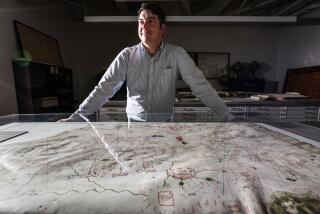With Satellites as the Guide, Drivers May Never Be Lost Again
- Share via
Map making has leaped into the digital age, substituting satellites and computers for the methods perfected over the centuries by explorers.
Instead of surveying instruments and long treks into remote terrain, the contemporary cartographer makes use of digital imaging, satellite reconnaissance and vast databanks on silicon chips.
High-end cars increasingly come with global positioning system units, which use satellites to determine precisely where the car is. The unit’s computer then produces an on-screen map to get drivers across town or across the continent, turn by turn, and tracks the car’s progress as it moves.
But there are times when the modern map maker has to turn away from the computer screen, go outside and see something with his or her own eyes.
*
“Sometimes, there is nothing that can replace a personal visit,” said Ryan Russo, manager of the local office of Navigation Technologies, a company that keeps a huge, detailed database of information on almost every street, road and highway in this country, as well as several in Europe.
The data includes addresses, whether or not a street is one-way, the number of lanes on a highway, the turns allowed at an intersection, speed limits and points of interest.
This data that NavTech and its competitors gather is sold for a variety of applications, including the GPS units in cars.
Global positioning system units use the database to plot exact directions from the car’s location (determined by satellite plotting) to almost any address in the country.
NavTech derived most of its data from aerial images and records compiled by government and private sources. But there are two situations that require on-site visits.
*
One occurs when an area becomes a boomtown, changing so quickly that the usual sources of information lag behind.
“Las Vegas is growing unbelievably fast,” said Russo, sitting in his office in Santa Fe Springs. “It’s like one of the old Warner Bros. cartoons. The asphalt rolls into place, street lights plunk down from the sky, houses spring up from the ground and swarms of people move on in.”
On Russo’s computer screen was a grid of cul de sacs and streets representing a new subdivision in Las Vegas. NavTech cars have been exploring the new parts of the city for several weeks.
“They go out as a two-person team,” Russo said. “One person drives and calls out all the information--what’s at an address, street signs, one-way streets, whatever. The other person takes it all down.
“They do this for 10 hours a day. It’s intense.”
Back at the Santa Fe Springs office, the information is entered into the NavTech database, which is updated every three months.
*
The other situation comes about when a client complains that a bit of information in the database is inaccurate. A NavTech employee has to go out and check.
Rod Coronel, 31, got into a company car in front of the office and switched on its unit. He punched in the location in question: a stretch of Lakewood Boulevard in Downey.
“Please proceed to the highlighted route,” said the unit in its computerized voice, and Coronel pulled into traffic.
Coronel enjoys getting out of the office, but dreads the prospect of a mistake in his territory. “When I find something is not right in our database, I get . . . “
He was interrupted by the GPS unit.
“Left turn ahead.”
Coronel made the left.
“Maybe ‘upset’ is too strong a word,” he continued, “but I don’t like it.”
Coronel, who grew up in the Philippines, has a geography degree from Cal State Fullerton. “Ever since I was a kid, I wanted to travel, so geography seemed to fit.”
When he dreamed of travel, Downey was not what he had in mind.
“I still think about all the places I want to go,” he said. “But this is interesting work.”
“Destination ahead,” the unit said.
Coronel turned onto a small street, Vista del Rosa. He made a U-turn, parked and pulled out a map brought from the office computer. It indicated that at the intersection ahead, only a right turn was permitted.
But the road was clearly marked--left was allowed too.
“We’ll have to change the database,” Coronel said.
Given that the company database covers almost every street in the United States, the error seemed truly minor.
Not to Coronel.
“It may look like something small, but it’s important,” he said. “Especially now that we have GPS. The unit would tell us we could only turn right. We might have to make some unnecessary turns to get to our destination.”
In other words, when databases are perfect, you would never have getting lost as an excuse for being late to work. The digital age does have its disadvantages.
More to Read
Inside the business of entertainment
The Wide Shot brings you news, analysis and insights on everything from streaming wars to production — and what it all means for the future.
You may occasionally receive promotional content from the Los Angeles Times.











